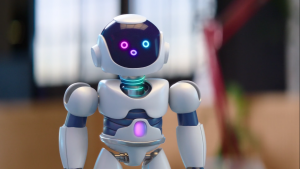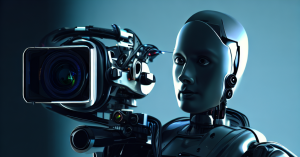Creating beautiful artwork or images can be difficult, time-consuming, and require specific skills and tools. As a result, AI art generators are becoming increasingly popular. They are easy to use and make stunning pictures in no time. But how do you know which is best for your needs? This exhaustive guide can help you choose the most suitable AI image generator. From understanding how they work to determining the right factors for choosing them, we’ll cover everything you need to know about them. So let’s dive in!
On this page
| → What is it? → Applications or use cases → How does it work? → Benefits (pros) | → Drawbacks (cons) → Limitations → Decision making factors → Future trends | → FAQs → Buying options → Conclusion |
What is an AI Art Generator?
An AI image generator is software powered by artificial intelligence designed to create visual art or images. These creators leverage advanced machine learning (ML) algorithms, such as Generative Adversarial Networks (GANs) or deep learning (DL) techniques, to generate original and creative images or art pieces. AI art generators can be used for various purposes, including digital art creation, graphic design, concept generation, and even personalized artwork, making it accessible and engaging for professional artists and non-artists.
Applications of AI Image Generators
AI art generators have many practical and real-world use cases across various industries. Some of the most notable uses include:
- Image generation: AI generators can create original images or artworks, offering unique content for artists, designers, advertisers, and social media users.
- Image manipulation: AI-powered tools can manipulate existing images, applying various artistic styles, filters, or effects to create visually appealing and transformative results.
- Image translation: AI can convert images from one domain to another, such as transforming a daytime image into a nighttime scene or a sketch into a photorealistic image.
- Image enhancement: AI algorithms can improve image quality by increasing resolution, reducing noise, or correcting exposure, color balance, and other visual elements.
- Image restoration: AI tools can restore old or damaged photos, reconstruct missing or deteriorated parts, and enhance overall image quality.
- Image segmentation: AI algorithms can identify and separate distinct objects or regions within an image, enabling applications in medical imaging, autonomous vehicles, and robotics.
- Image compression: AI-powered techniques can reduce the size of image files without compromising quality, allowing for more efficient storage and transmission of visual data.
- Object detection: AI models can detect and recognize specific objects or features within images, supporting applications in security, retail, manufacturing, and other industries.
- 3D modeling and rendering: AI image creators can create 3D models and realistic renderings, facilitating applications in architecture, product design, and virtual reality.
- Image synthesis: AI can synthesize new images based on textual descriptions or a combination of existing images, enabling more efficient content creation for marketing, advertising, and entertainment purposes.
These practical applications of AI art generators showcase the diverse capabilities of artificial intelligence in transforming how we create, process, and interact with visual content.
How does an AI Image Generator work?
The AI image generator software, powered by artificial intelligence, actively creates visual art or images using advanced machine learning and deep learning techniques. During training, the AI model analyzes a large dataset of images or artworks to learn various patterns, styles, and features present in the dataset, such as colors, textures, and shapes. In addition, it often employs complex neural network architectures, such as Generative Adversarial Networks (GANs) or Variational Autoencoders (VAEs), to process and generate new images.
Once trained, the generator part of the network creates new images by sampling from a latent space, representing the high-level features and patterns learned during the training phase. The generator produces new images by combining and reinterpreting these features. In the case of GANs, the discriminator evaluates the generated images, comparing them to authentic images from the training dataset. This process helps refine the generator’s output, ensuring its ideas are more realistic and visually appealing.
The final output of an AI art generator is a unique, creative, and often realistic image or artwork reflecting the styles, patterns, and features the model has learned from its training dataset. With the advancement of AI technology, we expect AI-generated art and images to become more sophisticated and versatile, presenting exciting possibilities for professional artists and non-artists alike.
Benefits (Pros) of AI Art Generators
AI image creators offer numerous benefits that make them valuable assets for individuals and businesses. Some of the most notable advantages include the following:
- Innovation: AI-powered creators can stimulate creativity and inspire new ideas by generating unique, never-before-seen visual content.
- Time savings: AI image generators can significantly reduce the time it takes to create, edit, or process visual content, enabling users to be more efficient and productive in their work.
- Cost-effectiveness: By automating various tasks and processes related to image creation and manipulation, AI tools can help businesses save on labor costs and other resources typically associated with manual content creation.
- Scalability: AI tools can quickly scale to accommodate larger projects, higher volumes of content, or more complex image generation tasks, making them suitable for a wide range of use cases.
- Consistency: AI-generated art or images can maintain a consistent visual style, quality, or theme, ensuring that content aligns with brand guidelines and aesthetic preferences.
- Accessibility: AI image generators democratize the creative process, enabling individuals with little artistic skills to generate professional-quality images and artworks.
- Personalization: You can use AI tools to create personalized visual content tailored to individual preferences or interests, improving user engagement and satisfaction.
These benefits showcase how AI art generators can positively impact the creative process and improve efficiency, cost savings, and enhanced user experiences.
Drawbacks (Cons) of AI Image Generators
While AI art generators offer numerous benefits, they also come with certain drawbacks that users should be aware of. Some of the most notable disadvantages include the following:
- Ethical concerns: The use of AI in art or image generation can raise ethical questions, particularly when generating realistic images of individuals without their consent or creating content that perpetuates stereotypes and biases.
- Misinterpretation of input: AI art generators might sometimes misinterpret user input or need help to understand the intended context, leading to an output that may not accurately reflect the desired result.
- Inappropriate content: AI systems may unintentionally generate inappropriate or offensive content due to biases in the training data or the inability to discern between appropriate and inappropriate content.
- Intellectual property concerns: AI-generated images can raise questions about ownership, copyright, and intellectual property rights, as the line between human-created content and machine-generated work becomes increasingly blurred.
- Loss of human touch: AI-generated art may need a more personal touch, emotions, or unique creativity that only human artists can provide, which could lead to a more sterile or generic feel in the content.
Despite these drawbacks, AI image generators continue to revolutionize the creative landscape and offer valuable tools for content creation, provided that users are aware of these potential challenges and approach the technology responsibly.
Limitations of AI Art Generators
Despite their numerous benefits, AI image generators have certain limitations regarding their capabilities. Some of the most significant limitations include the following:
- Dependence on data: AI image generators rely heavily on the quality and quantity of data used to train their models. This reliance means that biases or inaccuracies in the data can negatively impact the output.
- Sensitivity to input variations: Small changes in input parameters or instructions can sometimes lead to a vastly different output, making it challenging for users to fine-tune their desired results.
- Limited creativity: AI-generated art or images rely on patterns and trends identified in the training data; therefore, they may need help generating truly unique or groundbreaking visual content that deviates from these patterns.
- Inability to handle complex concepts: AI systems may struggle to generate art or images that accurately depict complex, abstract, or nuanced concepts, as they often rely on patterns and trends found in the training data, which may not always capture the full range of human creativity.
- Inconsistency in quality: AI-generated art or images might only sometimes maintain a consistent level of quality, with some outputs looking polished and professional. In contrast, others appear less refined or realistic.
Awareness of these limitations can help users manage their expectations and make informed decisions when using AI art generators for their creative projects.
Key Decision-Making Factors to Consider
When selecting an AI image generator, it is essential to consider several key decision-making factors to ensure you choose the right tool for your needs. These factors include:
- Specific requirements: Identify the primary purpose of using an AI tool, such as generating original artwork, manipulating existing images, or enhancing image quality, and then select a tool specializing in those areas.
- Output quality: Assess the quality of the generated art or images, considering factors such as realism, creativity, and the ability to handle complex concepts or styles.
- Customization options: Pick a tool that offers a high degree of customization, which allows tailoring the output to specific requirements and artistic vision.
- Data security and privacy: Select a tool that upholds rigorous data privacy and security standards to safeguard sensitive information and intellectual property.
- Ease of use: Find a tool that is user-friendly and easy to navigate, featuring intuitive interfaces and accessible functions.
- Scalability: Determine if the tool can handle the volume of content needed, both now and as content generation requirements grow.
- Integration: Verify whether the tool can integrate with existing tools, software, and workflows, facilitating the incorporation of AI-generated content into projects.
- Pricing: Examine various pricing plans and capabilities to find the best value for the budget.
- Support and updates: Evaluate customer support quality, training resources, and update frequency to ensure the tool stays relevant and up-to-date.
- Community and ecosystem: Choose a tool backed by a strong community and ecosystem of users, developers, and partners, guaranteeing that the tool remains innovative, up-to-date, and relevant in the long run.
These key factors will help you decide and select the best AI art generator to meet your creative needs and goals.
Future Trends & Opportunities
As artificial intelligence revolutionizes the art and image generation landscape, exciting new possibilities emerge. Here are the top trends and opportunities for AI image generators to keep an eye on:
- Enhanced realism and quality: Continually improving to produce increasingly realistic and high-quality images, rivaling those created by human artists or photographers.
- Greater customization and personalization: Developing the ability to create personalized and customized artwork based on individual preferences, tastes, and styles, making unique and tailored visual content more accessible.
- Multimodal content generation: Generating not only static images but also dynamic and interactive content, such as animations, videos, and augmented reality experiences.
- Improved style transfer and synthesis: AI image generators will become better at transferring the style of one artwork onto another, allowing users to create novel and original pieces by combining different artistic types and elements.
- Generative 3D modeling and design: Extending capabilities to include 3D modeling and design, empowering users to create intricate and detailed 3D objects, scenes, and environments.
- Integration with other creative tools: Seamlessly blending with existing design software, content management systems, and other innovative tools, making it easier for artists and designers to incorporate AI-generated content into their work.
- Ethical and responsible AI art creation: Ensuring that users employ these tools ethically and responsibly, addressing issues such as copyright, ownership, and potential misuse or manipulation of visual content.
Frequently Asked Questions (FAQs)
Q. Who owns AI-generated art?
A. There is no clear answer to this question, but the author or creator of generated content usually owns it.
Q. Can you sell AI-generated images?
A. Yes, you can sell AI-generated images. However, it is essential to understand your jurisdiction’s copyright and intellectual property laws before doing so.
Q. Does AI art violate copyright?
A. AI art can sometimes violate copyright laws if not licensed or credited correctly. Therefore, it is essential to research and ensures you have the appropriate licenses before using AI art.
Q. Is AI art going to replace artists or designers?
A. AI art can never replace true human creativity. However, it can be a great tool to help artists or designers create unique visuals.
Buying Options
AI art or image generators typically provide three main categories of buying options or plans that aim to meet the diverse needs and budgets of our users:
- Free plans: Many AI image generators offer free plans or trials that provide users limited access to their capabilities. Free plans are ideal for those who want to explore the basic functionalities of the tool or are just getting started. These plans may limit the number of images generated, the resolution, or access to certain features.
- Paid plans: Paid plans or subscriptions offer a more comprehensive set of features, higher-quality output, and increased usage limits. These plans typically come in different tiers, allowing users to choose a plan that best suits their needs and budget. Paid plans are suitable for individuals and businesses that require more advanced features and a higher volume of generated content.
- Custom plans: For users with unique requirements, some AI art generators may offer custom plans tailored to their specific needs. Custom plans may include features such as API access, additional customization options, priority support, or enterprise-level security and privacy. These plans are ideal for larger organizations, professional artists, or businesses with specialized requirements beyond standard plans’ scope.
Before choosing the most suitable option for your AI art or image generation needs, evaluate your specific needs, budget, and features provided by each plan.
Conclusion
The rapidly evolving landscape of AI art generators offers incredible potential for artists, designers, and enthusiasts alike. By understanding the key factors that contribute to the effectiveness of these tools, such as their features, capabilities, ease of use, and pricing, you can make an informed buying decision when selecting the best AI image generator for your unique needs. As you embark on your creative journey, keep an eye on emerging trends and advancements in AI technology that will further enhance your artistic pursuits. With the right AI art or image generator, you can unlock endless creative possibilities and transform how you create and experience visual art.
Let us know if this guide was valuable to you. Also, if you have any questions or feedback, let us know in the comments.



